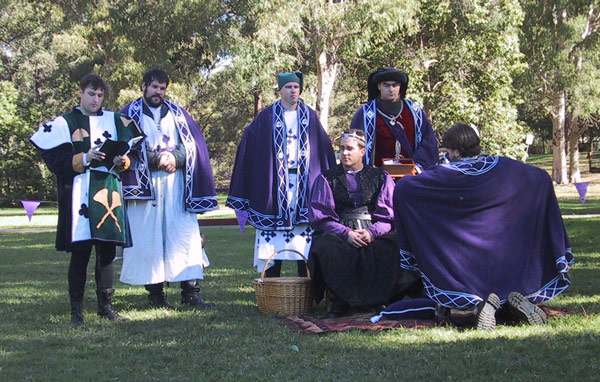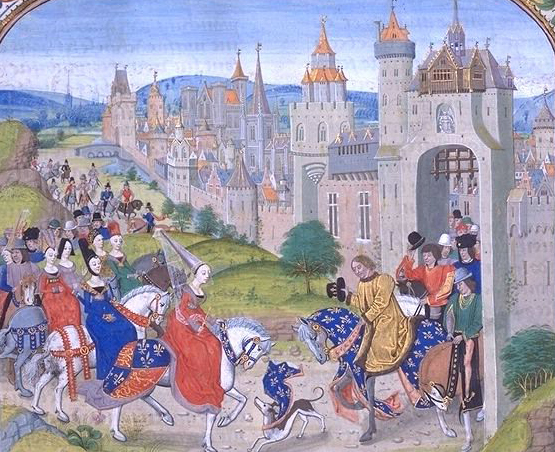While the origins of embroidery are unclear, it is known that for thousands of years, even pre Bronze age man, has used needle and thread to decorate and embellish fabrics that can be used as clothing, household items and personal accessories like these pouches (Staniland). The Opus Anglicanum pouches in discussion here, are predominantly from the late 13th to the early 14th Century and of European origin.
Around 1250-1350AD, examples of these exceptionally skilled embroideries started to emerge. While these highly valued works used the finest quality materials and were therefore expensive to produce, they were in much demand by both Church and State. Across Europe, nobility and papistry alike commissioned special works for ceremonial and ecclesiastical garments. This time period represents the pinnacle of English embroidery and the works produced came to be known as Opus Anglicanum, or ‘English Works’. It was not just the skilled execution that set these works apart - the shading and detail, beauty and expression of the figures was exceptional, and unique to this type of embroidery. Opus Anglicanum works achieved a vitality, realism and emotion in the characters depicted that had hitherto been absent in medieval embroidery.
The SCA holds regular events where members can congregate in an attempt to recreate the niceties of the middle ages. We hold tournaments, feasts, tavern nights, archery shoots, revels and many other occasions of various themes. An event can be greatly enhanced by creating an ambiance with the use of heraldic display. This article is intended to help people run a hall decorating crew for SCA events. The examples discussed are all relating to the hall decorations constructed for victory feast at May Crown ASXXXIX which was held in St Florian de la Riviere at the White’s Hill State School (Brisbane).
Working To A Theme
One of the principal items of furniture in the medieval household was a large heavy wooden bed, in which the lord and lady of the manor/castle slept. Beds of this kind had springs made of interlaced ropes or strips of leather. These springs were usually overlaid with a feather mattress, sheets, quilts, fur coverlets, and pillows. Many of these types of beds could be dismantled and taken along on the frequent trips a great lord made to his castles and other manors. The bed was often curtained, with linen hangings that pulled back in the daytime and closed at night to give privacy as well as protection from drafts.
St Florian de la Riviere has a set of ceremonial cloaks which are bestowed on the various champions that represent the Barony – the Baronial Champion; the Baronness’ Champion; the Arts and Sciences Champion and the Archery Champion. Volunteers have been embroidering the personal devices in a split stitch technique of each Baronial Champion to adorn the perpetual cloaks.

Embroidered Split Stitch Devices
I have embroidered several devices to adorn the Baronial cloaks for various champions. These devices have been embroidered using a simple split stitch technique on a tight-weave twill silk. Each device is executed by firstly starting with the charges. The charges (or identifiable items) are firstly outlined and then worked in rows of stitching inwards on each shape. The background or field colours are completed after all charges have been finished – again working areas from the outlines inwards towards the centre of each space.
You’ve displayed your heraldry on your standards, your gonfalons, your pennons, your clothing, your embroideries, your tent, your purse, your cutlery, your crockery, your chair and even your friends that have sat still long enough! Just when you think you’ve run out of places to display your device…. along comes the ultimate heraldic accessory in the form of an Heraldic Canine Coat!

Isabella arrives in Paris.
Jean Froissart, Chroniques 15th C
Bibliotheque National de France, Paris (BNF, FR 2643)
Belts and girdles of the medieval period are widely variable in style and design. From small and simple designs to belts with hugely ornate and richly furnished buckles and fittings. This diverse miscellany reflects the opportunity for fashionable self expression at various levels of society.
These styles of medieval belts are evident in a number of different sources. We see them documented in extant belt fragments, brass monuments, stone tomb effigies, paintings and in sculpture. They appear with regularity across these art forms of the 14th and 15th centuries, though some examples are as early as the 12thcentury. The heavily decorated plaque belts appear to have been a predominantly masculine dress accessory, and whilst not unknown, it seems relatively fewer appear worn by women.
First things first - to make a tabard, you must first decide what particular period your tabard should suit. This may be dictated by the fighter’s persona or the relevant time period of his armour or one of many other considerations. The Whyte Companie of St Michael depicted above is a household of 15th Century Burgundian persuasion and much of their pursuits are focused on that period and culture. Their tabards are likewise based on a 15th century Burgundian style and the ones depicted here are mostly machine appliquéd tabards constructed with velveteen, damasks, silk, brocade and various couching cords and fancy trim to achieve a rich textured appearance.


